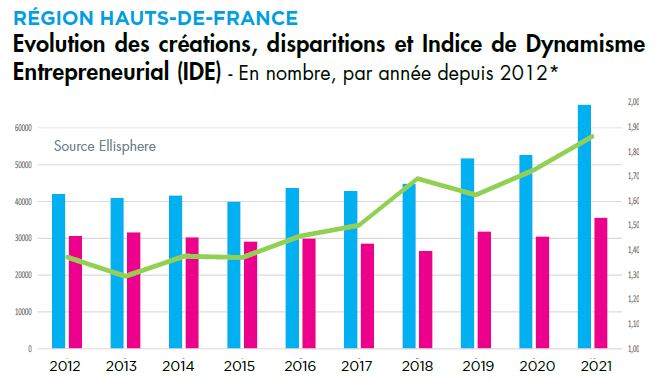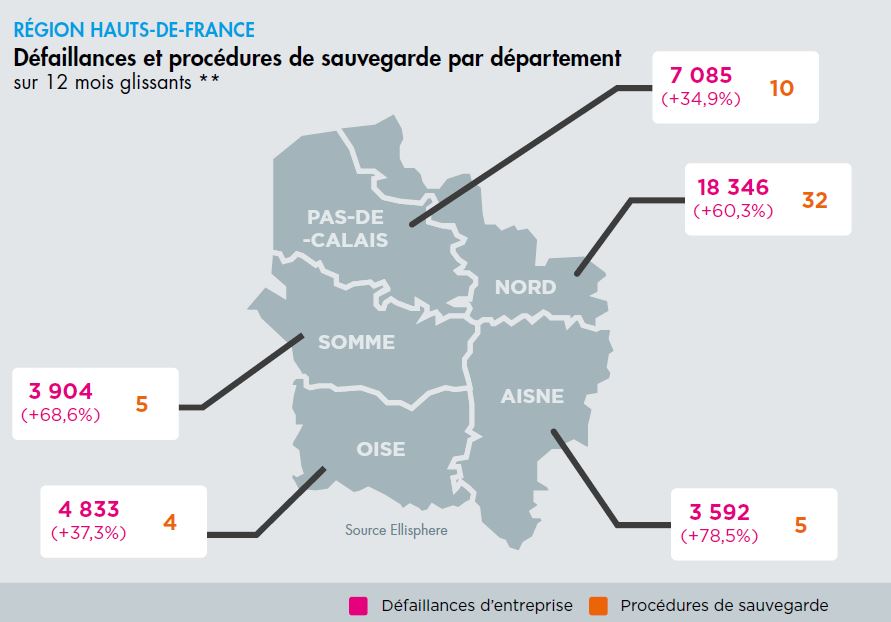The Hauts-de-France region ranks 6th in terms of the number of companies, i.e. 6.4% of all companies in metropolitan France, and 3rd in terms of the number of salaried employees (7.6% of all French employees).
The Nord department with the city of Lille, regional powerhouse
With 45.4% of companies and 56.5% of employees in the region, the Nord department remains the main driver of the regional economy. It is followed by the Pas-de-Calais, with respectively 21.6% of companies and 18.8% of employees in the Hauts-de-France.
Lille alone is home to a quarter of the region's companies and employees, far ahead of Amiens and Bethune. Lille is also among the top 10 French cities in terms of number of companies and employees. The sectoral representation is similar to that of the whole of France, with a top three composed of Building & Public Works (BTP), Public Services and Business Services, which together represent 56% of companies and nearly 54% of employees in the region. Distribution is in4th place, compared with 7th place for metropolitan France as a whole, with 7.3% of regional companies and 8.3% of employees. The weight of the Mulliez family is not to be overlooked, as six of the Distribution entities belonging to it are ranked among the top 10 regional employers.
An important dynamism
Despite the loss of inhabitants, the Hauts-de-France region remains a land of entrepreneurs. Between January 2021 and 2022, the population of active companies in the region rose by 7.2% (ahead of the Ile-de-France region), a rate of growth that is much higher than that of the whole of France, which recorded a 6.3% increase. The most dynamic sectors are Transport & Logistics (+39.4% of companies) and Energy (+16.4%) over one year.
However, this dynamism is often linked to windfall or cyclical effects. For new entrants in the Transport sector, the booster is last mile logistics with many micro-entrepreneurs working in parcel and meal delivery, and for Energy, that of connected installations of individuals or fixed structures (wind and solar turbines in particular). Activities which, if they provide additional income, are not always sustainable for the former and create few jobs for the latter. Over the period 2012-2022, the Hauts-de-France region has managed to renew its entrepreneurial population. On average, 1.5 new businesses were created for every one that disappeared. The crisis period since 2020 has not affected this dynamism. Over a 12-month rolling period to the end of March 2022, nearly 63,300 businesses were created in the region (+7.5%) for 37,800 that disappeared. However, the number of the latter has risen sharply (+54% over one year). Indeed, it remains difficult for companies to establish themselves permanently in the landscape, especially for the most recent ones, due to the lack of access to the various aids to support the Covid-19 crisis. These companies, more and more affected financially, have thus decided to voluntarily stop their activities rather than face bankruptcy.

Number of insolvencies on the rise
Over a 12-month sliding scale at the end of March 2022, 5.5% of business disappearances were the result of a judicial liquidation. Since 2012, this regional loss ratio has remained higher than at national level.
After three consecutive years of decline, linked first to the favorable economic climate in 2019 and then to the "whatever it takes" in 2020-2021, the number of insolvencies (opening of receivership or direct judicial liquidation) is on the rise again. The gradual cessation of aid, the inflationary economic situation and the maturity of loan repayments are now having a more lethal effect on companies.
In the Hauts-de-France region, over a 12-month rolling period to the end of April 2022, the increase was 16.5%, compared with 9.3% nationally, the highest rate of increase on record. Insolvencies in the Hauts-de-France represent 8.1% of all insolvencies nationwide (6th out of 13 regions). The Nord department (50% of the region's insolvencies) is particularly affected, with a 25.2% increase in the number of procedures. For the time being, only the department of Oise in the Hauts-de-France is resisting the rise in the number of insolvencies.

An internationally oriented positioning
The Hauts-de-France region has many international connections: freeways (A1, A16, A29, etc.), rail links (Lille-Paris TGV and Eurotunnel) and maritime links: three ports located in Boulogne-sur-Mer (fishing), Calais (passengers and goods) and Dunkirk.
France's fourth-largest exporting region (first in the agri-food sector), it also ranks third in terms of foreign investment projects on its soil, where 2,300 foreign companies are already established.
Among the dominant sectors of activity, we can of course mention the Food industry, but also the Automotive, Logistics, Distribution, E-commerce or I.T. (Information Technology).
In this last area, we would like to mention EuraTechnologies, an incubator and gas pedal for startups (present on four campuses: Lille, Roubaix, Saint-Quentin and Willems), the robotics cluster in Saint-Quentin with local companies specializing in digital technology (a fast-growing economic sector that creates jobs), and finally the Energy Hub in Amiens, which brings together some thirty French laboratories and industrial companies working on the development of tomorrow's batteries.
The Nord department is also the birthplace of many international brands: AUCHAN (a global player in distribution), LEROY MERLIN (pioneer of the ADEO group, European No. 1 in the DIY market), DECATHLON (sports and leisure), TEREOS (cooperative sugar group), ROQUETTE (supplier of pharmaceutical and nutraceutical products), KIABI (clothing and footwear), ARC INTERNATIONAL (tableware) or LESAFFRE (world reference player in micro-organism fermentation), to name but a few...


